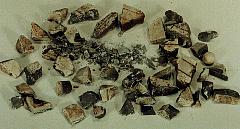|
 |
| Layout of Diorama components |
Once you have decided
on the scene you wish to model the next step is planning the layout, firstly
on a piece of chipboard or similar layout the major components to determine
the size of the base. The size of the base is important in the final appeal
of the diorama, too small a base will have everything crowded and cluttered
together while too large will have the pieces disappearing in the wide
open spaces.
Other simple rules when planning the layout are to always position the
buildings and vehicles (or aircraft, ships etc.) at an angle to the base
sides, otherwise the scene will look to rigid and sterile. Position the
larger items to the rear leaving the foreground relatively clear making
it easier to view the whole scene, also this will ensure the scene is
viewed from the angle to best advantage. If you want to highlight a particular
part of the diorama this can be done by having all the figures looking
in one direction thereby directing the viewers attention to that same
point.
 |
| Unpainted accessory items |
The final point to
remember is "balance", if the larger items are all to one side with only
a few figures on the other the scene will look out of balance, referring
to the completed diorama, the ruined building and armoured car have been
positioned at opposite corners with the smaller items, figures and accessories
placed diagonally to balance and "fill" the scene, if there is an empty
space remaining this can be filled with an extra figure or small accessory
or by added some extra groundcover (the grass in the right front corner).
Also don't be afraid to change things around after the initial planning
by adding figures rearranging the scene or changing the items used, Verlinden's
V-100 Armoured Car arrived after I had started the diorama and was substituted
for the M-109 as I felt this better fitted the scene.
 |
| Materials used in construction |
The next step is to
gather together all the small extras you will use, when it comes time
to place all these onto the diorama you may not need all of these or you
may require a few more to fill small spaces, again be flexible. And finally
all the materials that will be needed are placed close to hand, Polyfilla
for the groundwork with powder colour which is mixed in with the polyfilla
to give colour depth to the groundwork. The Aquadhere (or any other woodworking
glue) is used for the diluted white glue mix for sticking the smaller
items to the base. The various packs of ground cover scatter will be described
in more detail later.
Once the planning
of your diorama is complete it is now time to start work. The thing
to remember is that a diorama is basically a large kit in that it is
made up of various sub assemblies which are bought together in the final
construction.
 |
| Painted & weathered gear |
The small items of
equipment and personal gear must be finished with the same care and attention
to detail as the buildings, vehicles etc., or the diorama will look like
a model surrounded by lots of afterthoughts. The many accessories have
been individually painted and weathered using the same methods of washes
and drybrushing as the main components, the stencilling on the boxes and
crates are from various 'Verlinden' dry transfer sheets. As you can imagine
this is fairly time consuming but the end result is worth the effort and
will enhance your finished diorama.
The
Building
The ‘Verlinden' kit
No.111 "Vietnam/Middle East Ruin" is made up of 20 pieces cast in plaster
and after initial cleaning up the pieces are assembled using Thick Cyanoacrylate
glue (care must be taken when using this glue or you will end up with
your fingers as unwanted building extensions ).
 |
 |
| Unpainted building items |
Initial painting of building |
Small details are added
such as the wire reinforcements to the upper floor with thin wire inserted
into pre-drilled holes and the railings from plastic rod. The basic colours
are then brushed on, the whole building must be painted to seal the plaster
for the weathering which follows. After the paint has dried for at least
48 hours the first washes of light brown are added followed by darker
browns to highlight the texture, a wash is a mixture of about 90% thinner
and 10% paint (I find oil paints the best for washes, the pigment being
much finer the normal paints) which can be applied overall using a large
brush to tint the paintwork or with a fine brush to highlight the details
of the brickwork etc.
 |
 |
| Painted & weathered building |
Painting & weathered rubble |
After the wash has
dried a further 24 hours the building is then drybrushed with lighter
colours to further highlight to detail using an old stiff brush with short
bristles. Finally the larger pieces of rubble must also be painted and
weathered in the same manner so they will. blend with the ruin and don't
look like afterthoughts.
This method can be used for any plaster or resin buildings using appropriate
colours and adding as much extra detail as you wish. |








